高考英语完形填空考点整理学案 12 语法填空解题技巧(无答案)
文档属性
| 名称 | 高考英语完形填空考点整理学案 12 语法填空解题技巧(无答案) |
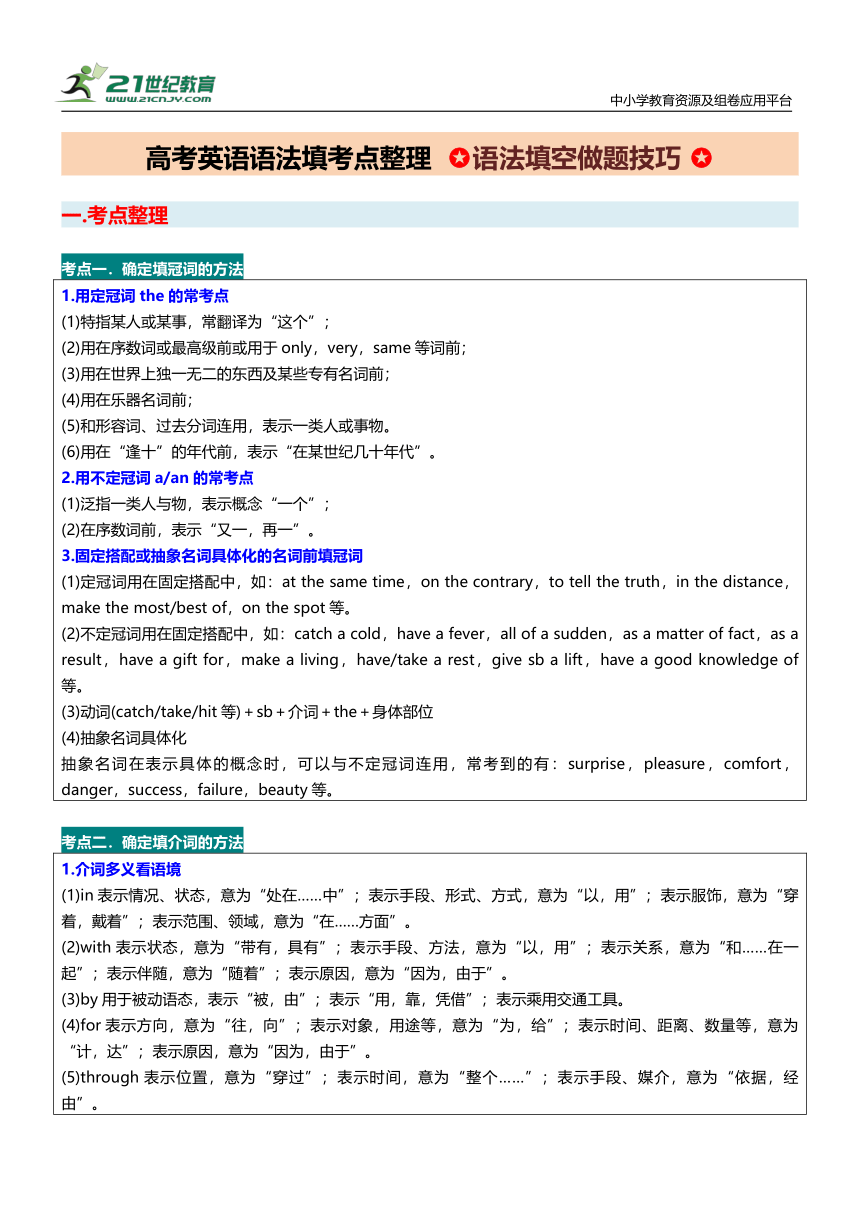
|
|
| 格式 | docx | ||
| 文件大小 | 167.4KB | ||
| 资源类型 | 试卷 | ||
| 版本资源 | 通用版 | ||
| 科目 | 英语 | ||
| 更新时间 | 2022-12-05 11:13:12 | ||
图片预览

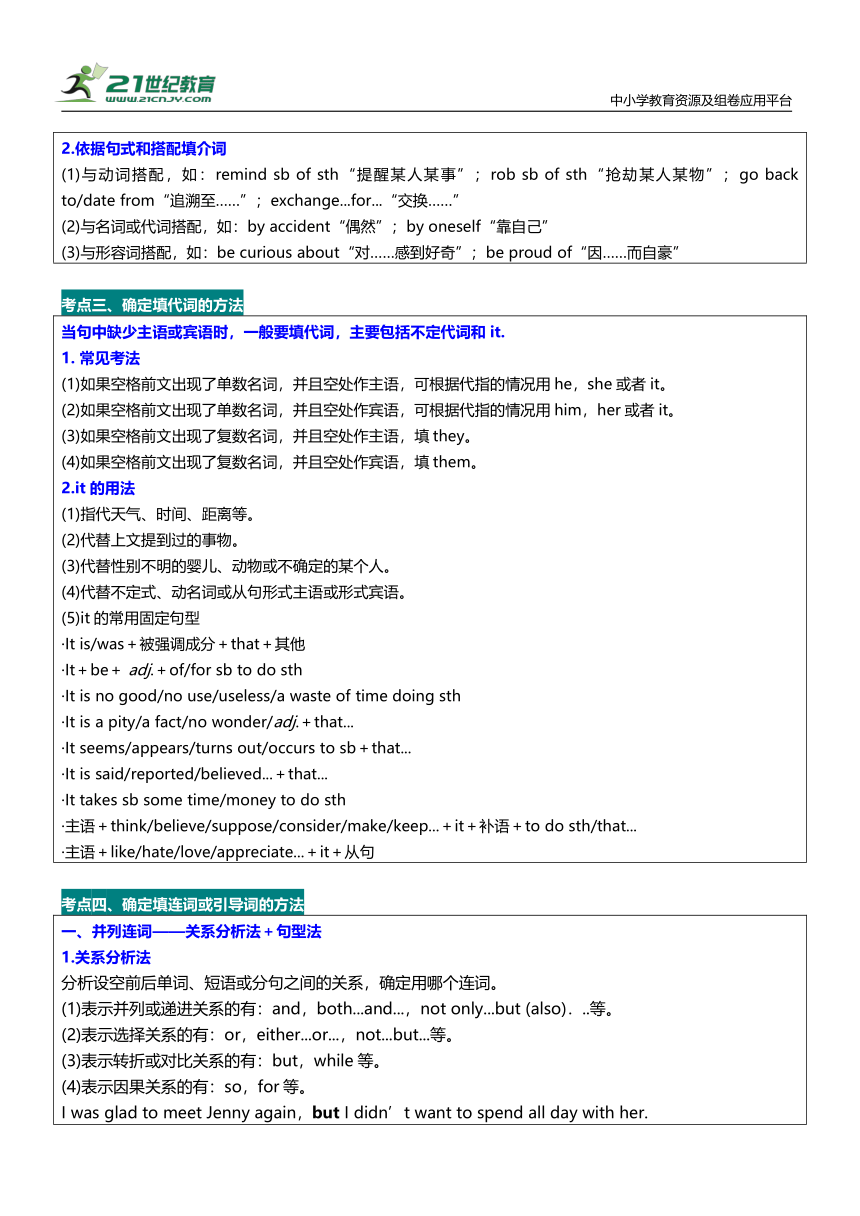
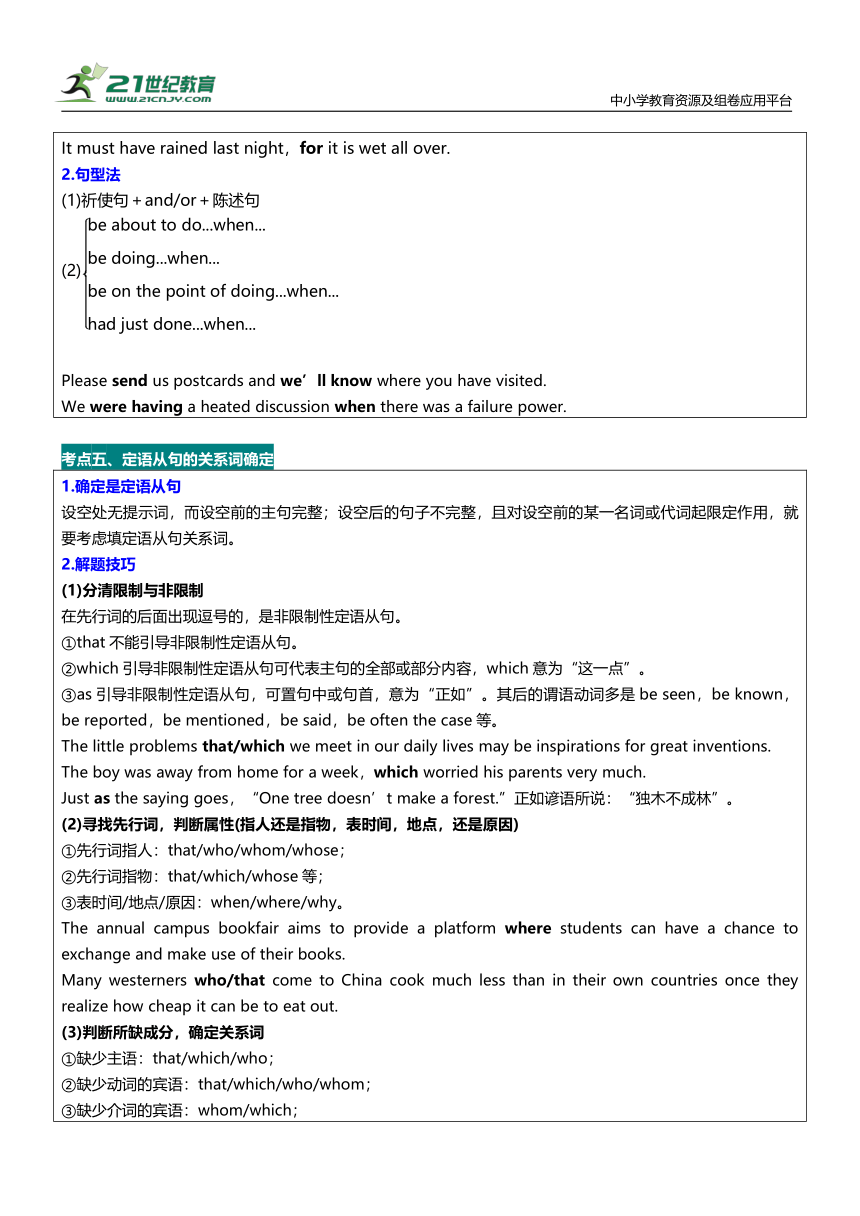
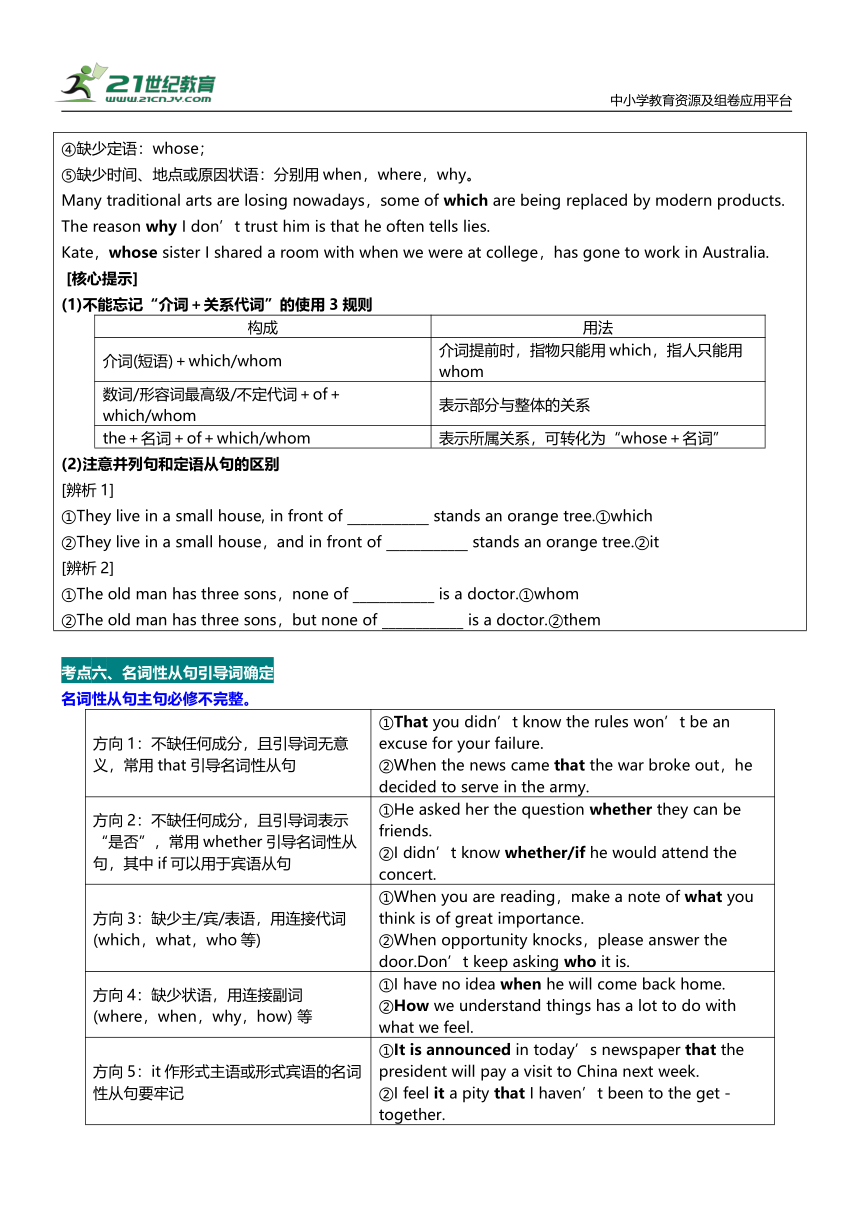
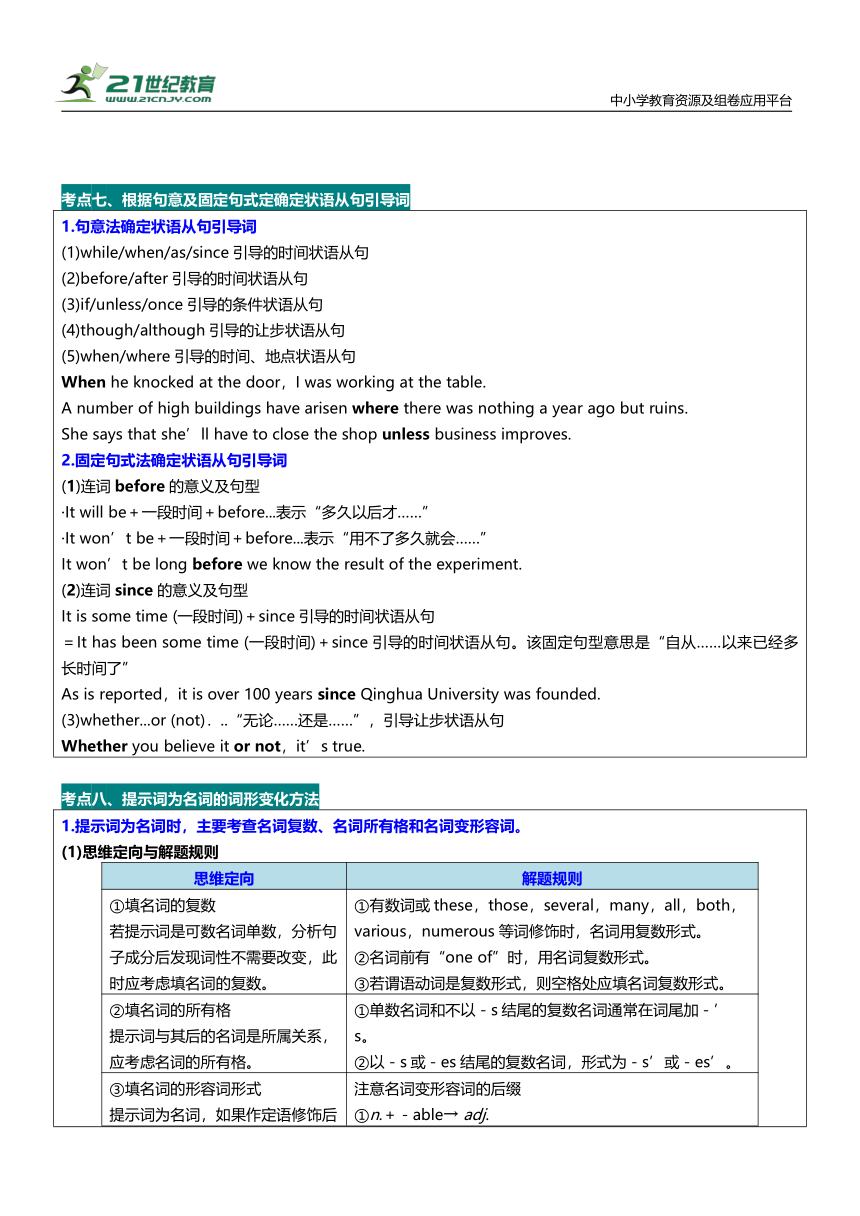
文档简介
中小学教育资源及组卷应用平台
高考英语语法填考点整理 语法填空做题技巧
一.考点整理
考点一.确定填冠词的方法
1.用定冠词the的常考点 (1)特指某人或某事,常翻译为“这个”; (2)用在序数词或最高级前或用于only,very,same等词前; (3)用在世界上独一无二的东西及某些专有名词前; (4)用在乐器名词前; (5)和形容词、过去分词连用,表示一类人或事物。 (6)用在“逢十”的年代前,表示“在某世纪几十年代”。 2.用不定冠词a/an的常考点 (1)泛指一类人与物,表示概念“一个”; (2)在序数词前,表示“又一,再一”。 3.固定搭配或抽象名词具体化的名词前填冠词 (1)定冠词用在固定搭配中,如:at the same time,on the contrary,to tell the truth,in the distance,make the most/best of,on the spot等。 (2)不定冠词用在固定搭配中,如:catch a cold,have a fever,all of a sudden,as a matter of fact,as a result,have a gift for,make a living,have/take a rest,give sb a lift,have a good knowledge of等。 (3)动词(catch/take/hit等)+sb+介词+the+身体部位 (4)抽象名词具体化 抽象名词在表示具体的概念时,可以与不定冠词连用,常考到的有:surprise,pleasure,comfort,danger,success,failure,beauty等。
考点二.确定填介词的方法
1.介词多义看语境 (1)in表示情况、状态,意为“处在……中”;表示手段、形式、方式,意为“以,用”;表示服饰,意为“穿着,戴着”;表示范围、领域,意为“在……方面”。 (2)with表示状态,意为“带有,具有”;表示手段、方法,意为“以,用”;表示关系,意为“和……在一起”;表示伴随,意为“随着”;表示原因,意为“因为,由于”。 (3)by用于被动语态,表示“被,由”;表示“用,靠,凭借”;表示乘用交通工具。 (4)for表示方向,意为“往,向”;表示对象,用途等,意为“为,给”;表示时间、距离、数量等,意为“计,达”;表示原因,意为“因为,由于”。 (5)through表示位置,意为“穿过”;表示时间,意为“整个……”;表示手段、媒介,意为“依据,经由”。 2.依据句式和搭配填介词 (1)与动词搭配,如:remind sb of sth“提醒某人某事”;rob sb of sth“抢劫某人某物”;go back to/date from“追溯至……”;exchange...for...“交换……” (2)与名词或代词搭配,如:by accident“偶然”;by oneself“靠自己” (3)与形容词搭配,如:be curious about“对……感到好奇”;be proud of“因……而自豪”
考点三、确定填代词的方法
当句中缺少主语或宾语时,一般要填代词,主要包括不定代词和it. 1. 常见考法 (1)如果空格前文出现了单数名词,并且空处作主语,可根据代指的情况用he,she或者it。 (2)如果空格前文出现了单数名词,并且空处作宾语,可根据代指的情况用him,her或者it。 (3)如果空格前文出现了复数名词,并且空处作主语,填they。 (4)如果空格前文出现了复数名词,并且空处作宾语,填them。 2.it的用法 (1)指代天气、时间、距离等。 (2)代替上文提到过的事物。 (3)代替性别不明的婴儿、动物或不确定的某个人。 (4)代替不定式、动名词或从句形式主语或形式宾语。 (5)it的常用固定句型 ·It is/was+被强调成分+that+其他 ·It+be+ adj.+of/for sb to do sth ·It is no good/no use/useless/a waste of time doing sth ·It is a pity/a fact/no wonder/adj.+that... ·It seems/appears/turns out/occurs to sb+that... ·It is said/reported/believed...+that... ·It takes sb some time/money to do sth ·主语+think/believe/suppose/consider/make/keep...+it+补语+to do sth/that... ·主语+like/hate/love/appreciate...+it+从句
考点四、确定填连词或引导词的方法
一、并列连词——关系分析法+句型法 1.关系分析法 分析设空前后单词、短语或分句之间的关系,确定用哪个连词。 (1)表示并列或递进关系的有:and,both...and...,not only...but (also)...等。 (2)表示选择关系的有:or,either...or...,not...but...等。 (3)表示转折或对比关系的有:but,while等。 (4)表示因果关系的有:so,for等。 I was glad to meet Jenny again,but I didn’t want to spend all day with her. It must have rained last night,for it is wet all over. 2.句型法 (1)祈使句+and/or+陈述句 (2) Please send us postcards and we’ll know where you have visited. We were having a heated discussion when there was a failure power.
考点五、定语从句的关系词确定
1.确定是定语从句 设空处无提示词,而设空前的主句完整;设空后的句子不完整,且对设空前的某一名词或代词起限定作用,就要考虑填定语从句关系词。 2.解题技巧 (1)分清限制与非限制 在先行词的后面出现逗号的,是非限制性定语从句。 ①that不能引导非限制性定语从句。 ②which引导非限制性定语从句可代表主句的全部或部分内容,which意为“这一点”。 ③as引导非限制性定语从句,可置句中或句首,意为“正如”。其后的谓语动词多是be seen,be known,be reported,be mentioned,be said,be often the case等。 The little problems that/which we meet in our daily lives may be inspirations for great inventions. The boy was away from home for a week,which worried his parents very much. Just as the saying goes,“One tree doesn’t make a forest.”正如谚语所说:“独木不成林”。 (2)寻找先行词,判断属性(指人还是指物,表时间,地点,还是原因) ①先行词指人:that/who/whom/whose; ②先行词指物:that/which/whose等; ③表时间/地点/原因:when/where/why。 The annual campus bookfair aims to provide a platform where students can have a chance to exchange and make use of their books. Many westerners who/that come to China cook much less than in their own countries once they realize how cheap it can be to eat out. (3)判断所缺成分,确定关系词 ①缺少主语:that/which/who; ②缺少动词的宾语:that/which/who/whom; ③缺少介词的宾语:whom/which; ④缺少定语:whose; ⑤缺少时间、地点或原因状语:分别用when,where,why。 Many traditional arts are losing nowadays,some of which are being replaced by modern products. The reason why I don’t trust him is that he often tells lies. Kate,whose sister I shared a room with when we were at college,has gone to work in Australia. [核心提示] (1)不能忘记“介词+关系代词”的使用3规则 构成用法介词(短语)+which/whom介词提前时,指物只能用which,指人只能用whom数词/形容词最高级/不定代词+of+which/whom表示部分与整体的关系the+名词+of+which/whom表示所属关系,可转化为“whose+名词”
(2)注意并列句和定语从句的区别 [辨析1] ①They live in a small house, in front of ____________ stands an orange tree.①which ②They live in a small house,and in front of ____________ stands an orange tree.②it [辨析2] ①The old man has three sons,none of ____________ is a doctor.①whom ②The old man has three sons,but none of ____________ is a doctor.②them
考点六、名词性从句引导词确定
名词性从句主句必修不完整。
方向1:不缺任何成分,且引导词无意义,常用that引导名词性从句 ①That you didn’t know the rules won’t be an excuse for your failure. ②When the news came that the war broke out,he decided to serve in the army.
方向2:不缺任何成分,且引导词表示“是否”,常用whether引导名词性从句,其中if可以用于宾语从句 ①He asked her the question whether they can be friends. ②I didn’t know whether/if he would attend the concert.
方向3:缺少主/宾/表语,用连接代词(which,what,who等) ①When you are reading,make a note of what you think is of great importance. ②When opportunity knocks,please answer the door.Don’t keep asking who it is.
方向4:缺少状语,用连接副词(where,when,why,how) 等 ①I have no idea when he will come back home. ②How we understand things has a lot to do with what we feel.
方向5:it作形式主语或形式宾语的名词性从句要牢记 ①It is announced in today’s newspaper that the president will pay a visit to China next week. ②I feel it a pity that I haven’t been to the get-together.
考点七、根据句意及固定句式定确定状语从句引导词
1.句意法确定状语从句引导词 (1)while/when/as/since引导的时间状语从句 (2)before/after引导的时间状语从句 (3)if/unless/once引导的条件状语从句 (4)though/although引导的让步状语从句 (5)when/where引导的时间、地点状语从句 When he knocked at the door,I was working at the table. A number of high buildings have arisen where there was nothing a year ago but ruins. She says that she’ll have to close the shop unless business improves. 2.固定句式法确定状语从句引导词 (1)连词before的意义及句型 ·It will be+一段时间+before...表示“多久以后才……” ·It won’t be+一段时间+before...表示“用不了多久就会……” It won’t be long before we know the result of the experiment. (2)连词since的意义及句型 It is some time (一段时间)+since引导的时间状语从句 =It has been some time (一段时间)+since引导的时间状语从句。该固定句型意思是“自从……以来已经多长时间了” As is reported,it is over 100 years since Qinghua University was founded. (3)whether...or (not)...“无论……还是……”,引导让步状语从句 Whether you believe it or not,it’s true.
考点八、提示词为名词的词形变化方法
1.提示词为名词时,主要考查名词复数、名词所有格和名词变形容词。 (1)思维定向与解题规则 思维定向解题规则①填名词的复数 若提示词是可数名词单数,分析句子成分后发现词性不需要改变,此时应考虑填名词的复数。①有数词或these,those,several,many,all,both,various,numerous等词修饰时,名词用复数形式。 ②名词前有“one of”时,用名词复数形式。 ③若谓语动词是复数形式,则空格处应填名词复数形式。②填名词的所有格 提示词与其后的名词是所属关系,应考虑名词的所有格。①单数名词和不以-s结尾的复数名词通常在词尾加-’s。 ②以-s或-es结尾的复数名词,形式为-s’或-es’。③填名词的形容词形式 提示词为名词,如果作定语修饰后面的名词,则一般考查名词变形容词。注意名词变形容词的后缀 ①n.+-able→ adj. value→valuable,reason→reasonable ②n.+-al→ adj. tradition→traditional ③n.+-ful→ adj. colour→colourful,help→helpful ④n.+-en→ adj. wood→wooden,gold→golden ⑤n.+-y→ adj. luck→lucky,dust→dusty
(2)名词变复数必记的三条规则 ①词尾是-s,-x,-ch,-sh时,一般加-es。bus公共汽车→buses coach 教练→coaches②词尾是辅音字母+y时,变y为i,再加-es,元音字母+y时直接加s。enemy→enemies敌人 hobby→hobbies业余爱好 toy→toys玩具③复数形式有特殊变化的名词child→children foot→feet man→men mouse→mice woman→women tooth→teeth criterion(标准)→criteria medium(传播媒介)→media
2.熟记名词变动词和形容词的前缀/后缀 前缀/后缀示例en-courage n.勇气→encourage vt.鼓励-enstrength n.力气→strengthen vt.加强-izeapology n.道歉→apologize v.道歉-alnature n.自然→natural adj.自然的-yhealth n.健康→healthy adj.健康的-fulhelp n.帮助→helpful adj.有帮助的-ousdanger n.危险→dangerous adj.危险的-tiveimpression n.印象→impressive adj.印象深刻的-ibleaccess n.进入,使用权,通路→accessible adj.容易取得的
考点九、提示词为形容词的词性变化
1.思维定向与解题规则 思维定向解题规则形容词转换为副词若空白处修饰动词、形容词、副词或全句,则应填副词形式。形容词添加词缀变反义词根据句意和前后逻辑关系,确定句意表否定时,添加否定前缀(un-,im-,dis-等)或否定后缀(-less)变为反义词。形容词转换为比较级、最高级(1)等级判定看标志 ①题目中有much,far,still,even,rather,a little,a bit,a lot,a great deal,than等标志性词汇用比较级。 ②设空后有表示范围的标志词in,of,among等用最高级。 ③设空前有one of the,the+序数词等修饰词,用最高级。 (2)利用固定句型 ①“the+比较级...,the+比较级...”表示“越……越……”。 ②“比较级+and+比较级”,表“越来越……”。 ③“否定词+比较级”表示最高级含义。 (3)利用隐含信息判断 句中虽没有than等标志词,但暗含比较级,也需要用比较级。
2.形容词变副词的特别规则 以e结尾的一般不去e,直接加-lyimmediate→immediately brave→bravely一些以e结尾的形容词去e加-(l)ytrue→truly simple→simply gentle→gently possible→possibly“辅音字母+y”结尾,改-y为-i,再加-lyhappy→happily easy→easily以-ic结尾,加-allyeconomic→economically basic→basically
考点十、提示词为代词的解题方法
解题规则 人称 类别 单数第一人称第二人称第三人称人称 代词主格Iyouhe/she/it宾格meyouhim/her/it物主 代词形容词性myyourhis/her/its名词性mineyourshis/hers/its反身代词myselfyourselfhimself/herself/itself
人称 类别 复数第一人称第二人称第三人称人称 代词主格weyouthey宾格usyouthem物主 代词形容词性ouryourtheir名词性oursyourstheirs反身代词ourselvesyourselvesthemselves
人称代词、物主代词和反身代词的用法: (1)作主语:人称代词主格(I,we,you,he等) (2)作宾语/表语:人称代词宾格(me,us,him;them;it等)、名词性物主代词(ours,mine,yours,its等) (3)作定语:形容词性物主代词(our,my,your,their等) (4)如果宾语与主语是指同一人,用反身代词(myself,yourself,itself等) (5)填it的情况:作形式主语或形式宾语;指代前面提到的同一个事物或情况。 (6)that,those作替代词,用来代替已提到的名词,以避免重复。
考点十一、如何确定作谓语和作何种谓语
1.如何确定谓语动词的时态 最近几年高考语法填空最常考的时态是一般过去时、一般现在时和现在完成时。可以通过以下方式确定时态。 思维定向解题原则慧眼识别 标志词(1)一般过去时的标志词:yesterday,last year,in 2018,two days ago等 (2)一般现在时的标志词:often,usually,always等 (3)现在完成时的标志词:since,recently,in the past/last few years,so far,in recent years;for+时间段等瞻前顾后 找并列表示并列关系的谓语动词往往时态一致,如:and,but,not only...but also连接的句子时态相呼应,应该一致。通过动作 先后关系当句中有两个或两个以上的动词时,我们可以根据动作发生的先后关系来判定时态。通过“语境 暗示”法在时间状语和其他参照物都不明显的情况下,通过上下文的语境暗示,也是解决时态问题的一条行之有效的方法。
2.如何确定谓语动词的语态 分析语境,弄明白所给动词与其对应的主语之间的逻辑关系是确定谓语动词语态的关键。如果所给动词的主语是这个动作的执行者,该动词就用主动语态;如所给动词的主语是这个动词的承受者,该动词就用被动语态。 3.如何确定谓语动词的单复数 考生答题时不仅要考虑谓语动词的时态和语态,还要时刻提醒“主谓一致”也是高考考查的重要一环。 可数名词单数、不可数名词及第三人称代词(he,she,it)作主语时谓语动词用单数;可数名词复数及第一、二、三人称复数(we,you,they)作主语时谓语动词用复数。牢记以下几种主谓一致的情况。 思维定向解题原则定语从句中主谓一致在定语从句中,关系代词that,who,which等作主语时,其谓语动词的数应与主句中先行词的数一致。非谓语和主语从句作主语非谓语动词、名词性从句作主语,谓语动词一般用单数。但what引导的主语从句表示复数概念时,谓语动词用复数。就近原则由either...or...,neither...nor...,not...but...,not only...but also...等连接的并列主语,谓语动词常与最近的主语在人称和数上保持一致。就远原则主语后跟有with,together with,as well as,but,except,along with,rather than等引起的短语时,谓语动词的数要与前面的主语保持一致。
考点十二、如何确定非谓语动词
1.判断非谓语动词形式的2个基本原则 主被动原则逻辑主语与非谓语动词是主谓关系时,用v.-ing形式;是动宾关系时用 v.-ed形式。时间先后原则非谓语动词表示正在进行,用 v.-ing形式;表示已经完成,用 v.-ed形式;表示将来发生的动作,用不定式to do形式。
(2)不定式作状语 动词不定式可以用作目的状语。注意其他非谓语动词形式不能用作目的状语。To raise students’ awareness of traditional Chinese culture,our school will hold Chinese Chess Contest this Saturday at the Student Center.only to do sth为不定式作结果状语,表示出乎意料的结果,v.-ing作状语表示自然而然的结果。We hurried to the station,only to be told that the train had left.形容词或过去分词作表语时,后接不定式作状语。常见词有:happy,lucky,anxious,proud,disappointed,surprised,delighted,foolish,pleased,fortunate等。You will never know how happy I was to see her yesterday.牢记“主语+系动词+表语(形容词)+to do”句式,不定式的主动形式表示被动意义。As far as I’m concerned,the problem is easy to deal with.
现在分词、过去分词、动词不定式作定语的区别 思维定向解题规则真题示例赏析现在分词 作定语(1)现在分词作定语表示主动、正在进行; (2)若表示被动且正在发生的动作用being done 结构。Today there are more airplanes carrying more people than ever before in the sky. The meeting being held now is of great importance to us all.过去分词 作定语过去分词作定语表示被动、完成The meeting held yesterday is of great importance to us all.动词不定 式作定语不定式作后置定语表示动作尚未发生。The meeting to be held tomorrow is of great importance to us all.
注意:表示心理状态的动词-ing形式的形容词,意为“令人……的”;动词-ed形式的形容词,意为“(人)感到……的”,也可修饰体现内心感受的look,expression,tears,smile,voice等名词。 On hearing the exciting news,she shouted in an excited voice. (4)不定式作后置定语的两种情况 (1)由序数词、the only,the last,the next或形容词最高级修饰的名词常用不定式作定语。 I don’t think Henry is the best man to do the job. (2)当被修饰的名词是ability,attempt,chance,desire,plan,need,intention,way,wish等词时,常用不定式作定语。 He was lucky to get the good chance to go abroad for further study. 3.非谓语动词作宾语 (1)只能跟不定式作宾语的动词(短语) 三个希望两答应(hope,wish,expect,agree,promise) 两个要求莫拒绝(demand,ask,refuse) 设法学会做决定(manage,learn,decide/determine) 不要假装在选择(pretend,choose/select) 打算提出俩计划(intend,offer,plan,mean) 申请失败负担起(apply,fail,afford) 准备愿望又碰巧(prepare,desire,happen) This is the reason why he refused to accept the fact. 这就是为什么他不想接受这个事实的原因。 此外,afford,happen,threaten,can’t wait to do sth等也要用不定式作宾语。 (2)只能跟动名词作宾语的动词(短语) 喜欢考虑不避免(enjoy,consider,escape,avoid) 不禁放弃太冒险(cannot help,give up,risk) 感激承认很值得(appreciate,admit,be worth) 介意想象莫推延(mind,imagine,delay,put off) 允许完成是期望(allow,permit,finish,look forward to) 建议继续勤操练(suggest,go on,practise) 致力原谅要坚持(be devoted to,excuse,insist on) 继续成功不错过(keep on,succeed in,miss) Given another ten days,we are sure to finish repairing the machine. Most students object to being charged for parking on the campus. 4.非谓语动词作宾语补足语 (1)下列动词常用带to的不定式作宾语补足语 advise,allow,appoint,believe,cause,challenge,command,compel,consider,declare,drive,enable,encourage,forbid,force,hire,instruct,invite,judge,know,like,order,permit等。 He commanded us to finish the work in an hour. Father will not allow us to play in the street. (2)下列动词常用不带to的不定式作宾语补足语(主动语态中) 使役动词(make,let,have);感官动词(see,observe,hear,notice) His mother made him sweep the floor every day. (3)过去分词作宾语补足语表示被动、完成 常用过去分词作宾语补足语的动词有:have,make,get,find,see,notice,watch,hear,feel,want,like等。 The teacher won’t like the problem discussed at the moment. (4)现在分词作宾语补足语表示主动、进行 常用现在分词作宾语补足语的词语有feel,find,hear,notice,observe,see,watch,get,have,keep,leave,send,set,listen to,look at等。 He stood at the window,from where he could see his classmates playing basketball on the playground.
考点十二、如何确定词性转换
如果所给动词既不作谓语,也不作非谓语,则一般应进行词性转换,通常变为名词。 On the morning of her grandson’s wedding,Peg McCormack received some bad news.The 91-year-old was in the hospital after a fall when she found out she would be unable to attend the ____________ (celebrate) in Madison,New Jersey. 答案 celebration [分析句子结构可知,36空处既不作谓语,也不作非谓语,由空前的the可知,空处需要填名词形式。故答案为celebration。
二.语法填空专练
Giant Pandas, one of the rarest animals in the world, are not only regarded as China’s national treasure, but also beloved by people around the world. Chengdu Panda Base is the world’s only museum ____61____ focuses entirely on the endangered giant pandas.
Located in the north Chengdu suburb with only 10 km to the city center, this base was first set up in 1987 with six sick and hungry giant pandas which ____62____ (save) from the wild nature. And now, Chengdu Panda Base is the home of more than 150 giant pandas and also the world’s largest giant panda ____63____ (science) research base to ____64____ (close) interact with those lovable black and white animals.
If you are not satisfied ____65____ just watching the pandas but want to have a closer contact with them, you can try Panda Volunteer Programs in other panda bases in Sichuan. At present, there are three panda bases ____66____ (provide) this volunteer program. Dujiangyan Panda Base is the most convenient one____67____ it is near to Chengdu City. Bifengxia Panda Base provides more chances to see little panda ____68____ (baby) and Shenshuping Panda Base is where you can experience more natural and primitive living environment of pandas.
In the volunteer program, you will follow the instruction of the staff ____69____ (feed) the pandas, clean _____70_____ (they) fences, prepare cakes for panda, watch some panda- related documentaries, etc. It is quite a meaningful and memorable experience.
Now, a popular plant-based meal subscription service ____71____ (offer) the UK’s biggest meat-eater the chance to earn 50,000 ($68,000) by going vegan (严格的素食主义的) for three months, and waiting for the brave and lucky one.
Vibrant Vegan recently made an announcement ____72____ it is on the lookout for a Vegan Curious Coordinator, a die-hard meat-eater willing to experience an exclusively vegan lifestyle for at least three months. The ____73____ (select) person will have to sign a contract (合同), promising not to consume any animal-based foods during ____74____ three-month trial. At the same time, he/she is expected to encourage others ____75____ (give) veganism a go on social media. If he/she abides by (遵守) that ____76____ (agree), he/she stands to earn the equivalent of a 50,000 salary.
“As we head into the New Year, we at Vibrant Vegan want to not only show the health and environmental benefits of being vegan that we hear so much about, but also highlight that vegan food can and should ____77____ (enjoy) by everyone—even the UK’s biggest meat lover,” said Ian Burke Hamilton, ____78____ was the founder of Vibrant Vegan.
Actually, the company’s idea to get a meat-eater as ____79____ (it) Vegan Curious Coordinator was inspired by a survey of 15,000 meat-eaters, in which 34% of them admitted to being _____80_____ (particular) curious about going vegan.
高考英语语法填考点整理 语法填空做题技巧
一.考点整理
考点一.确定填冠词的方法
1.用定冠词the的常考点 (1)特指某人或某事,常翻译为“这个”; (2)用在序数词或最高级前或用于only,very,same等词前; (3)用在世界上独一无二的东西及某些专有名词前; (4)用在乐器名词前; (5)和形容词、过去分词连用,表示一类人或事物。 (6)用在“逢十”的年代前,表示“在某世纪几十年代”。 2.用不定冠词a/an的常考点 (1)泛指一类人与物,表示概念“一个”; (2)在序数词前,表示“又一,再一”。 3.固定搭配或抽象名词具体化的名词前填冠词 (1)定冠词用在固定搭配中,如:at the same time,on the contrary,to tell the truth,in the distance,make the most/best of,on the spot等。 (2)不定冠词用在固定搭配中,如:catch a cold,have a fever,all of a sudden,as a matter of fact,as a result,have a gift for,make a living,have/take a rest,give sb a lift,have a good knowledge of等。 (3)动词(catch/take/hit等)+sb+介词+the+身体部位 (4)抽象名词具体化 抽象名词在表示具体的概念时,可以与不定冠词连用,常考到的有:surprise,pleasure,comfort,danger,success,failure,beauty等。
考点二.确定填介词的方法
1.介词多义看语境 (1)in表示情况、状态,意为“处在……中”;表示手段、形式、方式,意为“以,用”;表示服饰,意为“穿着,戴着”;表示范围、领域,意为“在……方面”。 (2)with表示状态,意为“带有,具有”;表示手段、方法,意为“以,用”;表示关系,意为“和……在一起”;表示伴随,意为“随着”;表示原因,意为“因为,由于”。 (3)by用于被动语态,表示“被,由”;表示“用,靠,凭借”;表示乘用交通工具。 (4)for表示方向,意为“往,向”;表示对象,用途等,意为“为,给”;表示时间、距离、数量等,意为“计,达”;表示原因,意为“因为,由于”。 (5)through表示位置,意为“穿过”;表示时间,意为“整个……”;表示手段、媒介,意为“依据,经由”。 2.依据句式和搭配填介词 (1)与动词搭配,如:remind sb of sth“提醒某人某事”;rob sb of sth“抢劫某人某物”;go back to/date from“追溯至……”;exchange...for...“交换……” (2)与名词或代词搭配,如:by accident“偶然”;by oneself“靠自己” (3)与形容词搭配,如:be curious about“对……感到好奇”;be proud of“因……而自豪”
考点三、确定填代词的方法
当句中缺少主语或宾语时,一般要填代词,主要包括不定代词和it. 1. 常见考法 (1)如果空格前文出现了单数名词,并且空处作主语,可根据代指的情况用he,she或者it。 (2)如果空格前文出现了单数名词,并且空处作宾语,可根据代指的情况用him,her或者it。 (3)如果空格前文出现了复数名词,并且空处作主语,填they。 (4)如果空格前文出现了复数名词,并且空处作宾语,填them。 2.it的用法 (1)指代天气、时间、距离等。 (2)代替上文提到过的事物。 (3)代替性别不明的婴儿、动物或不确定的某个人。 (4)代替不定式、动名词或从句形式主语或形式宾语。 (5)it的常用固定句型 ·It is/was+被强调成分+that+其他 ·It+be+ adj.+of/for sb to do sth ·It is no good/no use/useless/a waste of time doing sth ·It is a pity/a fact/no wonder/adj.+that... ·It seems/appears/turns out/occurs to sb+that... ·It is said/reported/believed...+that... ·It takes sb some time/money to do sth ·主语+think/believe/suppose/consider/make/keep...+it+补语+to do sth/that... ·主语+like/hate/love/appreciate...+it+从句
考点四、确定填连词或引导词的方法
一、并列连词——关系分析法+句型法 1.关系分析法 分析设空前后单词、短语或分句之间的关系,确定用哪个连词。 (1)表示并列或递进关系的有:and,both...and...,not only...but (also)...等。 (2)表示选择关系的有:or,either...or...,not...but...等。 (3)表示转折或对比关系的有:but,while等。 (4)表示因果关系的有:so,for等。 I was glad to meet Jenny again,but I didn’t want to spend all day with her. It must have rained last night,for it is wet all over. 2.句型法 (1)祈使句+and/or+陈述句 (2) Please send us postcards and we’ll know where you have visited. We were having a heated discussion when there was a failure power.
考点五、定语从句的关系词确定
1.确定是定语从句 设空处无提示词,而设空前的主句完整;设空后的句子不完整,且对设空前的某一名词或代词起限定作用,就要考虑填定语从句关系词。 2.解题技巧 (1)分清限制与非限制 在先行词的后面出现逗号的,是非限制性定语从句。 ①that不能引导非限制性定语从句。 ②which引导非限制性定语从句可代表主句的全部或部分内容,which意为“这一点”。 ③as引导非限制性定语从句,可置句中或句首,意为“正如”。其后的谓语动词多是be seen,be known,be reported,be mentioned,be said,be often the case等。 The little problems that/which we meet in our daily lives may be inspirations for great inventions. The boy was away from home for a week,which worried his parents very much. Just as the saying goes,“One tree doesn’t make a forest.”正如谚语所说:“独木不成林”。 (2)寻找先行词,判断属性(指人还是指物,表时间,地点,还是原因) ①先行词指人:that/who/whom/whose; ②先行词指物:that/which/whose等; ③表时间/地点/原因:when/where/why。 The annual campus bookfair aims to provide a platform where students can have a chance to exchange and make use of their books. Many westerners who/that come to China cook much less than in their own countries once they realize how cheap it can be to eat out. (3)判断所缺成分,确定关系词 ①缺少主语:that/which/who; ②缺少动词的宾语:that/which/who/whom; ③缺少介词的宾语:whom/which; ④缺少定语:whose; ⑤缺少时间、地点或原因状语:分别用when,where,why。 Many traditional arts are losing nowadays,some of which are being replaced by modern products. The reason why I don’t trust him is that he often tells lies. Kate,whose sister I shared a room with when we were at college,has gone to work in Australia. [核心提示] (1)不能忘记“介词+关系代词”的使用3规则 构成用法介词(短语)+which/whom介词提前时,指物只能用which,指人只能用whom数词/形容词最高级/不定代词+of+which/whom表示部分与整体的关系the+名词+of+which/whom表示所属关系,可转化为“whose+名词”
(2)注意并列句和定语从句的区别 [辨析1] ①They live in a small house, in front of ____________ stands an orange tree.①which ②They live in a small house,and in front of ____________ stands an orange tree.②it [辨析2] ①The old man has three sons,none of ____________ is a doctor.①whom ②The old man has three sons,but none of ____________ is a doctor.②them
考点六、名词性从句引导词确定
名词性从句主句必修不完整。
方向1:不缺任何成分,且引导词无意义,常用that引导名词性从句 ①That you didn’t know the rules won’t be an excuse for your failure. ②When the news came that the war broke out,he decided to serve in the army.
方向2:不缺任何成分,且引导词表示“是否”,常用whether引导名词性从句,其中if可以用于宾语从句 ①He asked her the question whether they can be friends. ②I didn’t know whether/if he would attend the concert.
方向3:缺少主/宾/表语,用连接代词(which,what,who等) ①When you are reading,make a note of what you think is of great importance. ②When opportunity knocks,please answer the door.Don’t keep asking who it is.
方向4:缺少状语,用连接副词(where,when,why,how) 等 ①I have no idea when he will come back home. ②How we understand things has a lot to do with what we feel.
方向5:it作形式主语或形式宾语的名词性从句要牢记 ①It is announced in today’s newspaper that the president will pay a visit to China next week. ②I feel it a pity that I haven’t been to the get-together.
考点七、根据句意及固定句式定确定状语从句引导词
1.句意法确定状语从句引导词 (1)while/when/as/since引导的时间状语从句 (2)before/after引导的时间状语从句 (3)if/unless/once引导的条件状语从句 (4)though/although引导的让步状语从句 (5)when/where引导的时间、地点状语从句 When he knocked at the door,I was working at the table. A number of high buildings have arisen where there was nothing a year ago but ruins. She says that she’ll have to close the shop unless business improves. 2.固定句式法确定状语从句引导词 (1)连词before的意义及句型 ·It will be+一段时间+before...表示“多久以后才……” ·It won’t be+一段时间+before...表示“用不了多久就会……” It won’t be long before we know the result of the experiment. (2)连词since的意义及句型 It is some time (一段时间)+since引导的时间状语从句 =It has been some time (一段时间)+since引导的时间状语从句。该固定句型意思是“自从……以来已经多长时间了” As is reported,it is over 100 years since Qinghua University was founded. (3)whether...or (not)...“无论……还是……”,引导让步状语从句 Whether you believe it or not,it’s true.
考点八、提示词为名词的词形变化方法
1.提示词为名词时,主要考查名词复数、名词所有格和名词变形容词。 (1)思维定向与解题规则 思维定向解题规则①填名词的复数 若提示词是可数名词单数,分析句子成分后发现词性不需要改变,此时应考虑填名词的复数。①有数词或these,those,several,many,all,both,various,numerous等词修饰时,名词用复数形式。 ②名词前有“one of”时,用名词复数形式。 ③若谓语动词是复数形式,则空格处应填名词复数形式。②填名词的所有格 提示词与其后的名词是所属关系,应考虑名词的所有格。①单数名词和不以-s结尾的复数名词通常在词尾加-’s。 ②以-s或-es结尾的复数名词,形式为-s’或-es’。③填名词的形容词形式 提示词为名词,如果作定语修饰后面的名词,则一般考查名词变形容词。注意名词变形容词的后缀 ①n.+-able→ adj. value→valuable,reason→reasonable ②n.+-al→ adj. tradition→traditional ③n.+-ful→ adj. colour→colourful,help→helpful ④n.+-en→ adj. wood→wooden,gold→golden ⑤n.+-y→ adj. luck→lucky,dust→dusty
(2)名词变复数必记的三条规则 ①词尾是-s,-x,-ch,-sh时,一般加-es。bus公共汽车→buses coach 教练→coaches②词尾是辅音字母+y时,变y为i,再加-es,元音字母+y时直接加s。enemy→enemies敌人 hobby→hobbies业余爱好 toy→toys玩具③复数形式有特殊变化的名词child→children foot→feet man→men mouse→mice woman→women tooth→teeth criterion(标准)→criteria medium(传播媒介)→media
2.熟记名词变动词和形容词的前缀/后缀 前缀/后缀示例en-courage n.勇气→encourage vt.鼓励-enstrength n.力气→strengthen vt.加强-izeapology n.道歉→apologize v.道歉-alnature n.自然→natural adj.自然的-yhealth n.健康→healthy adj.健康的-fulhelp n.帮助→helpful adj.有帮助的-ousdanger n.危险→dangerous adj.危险的-tiveimpression n.印象→impressive adj.印象深刻的-ibleaccess n.进入,使用权,通路→accessible adj.容易取得的
考点九、提示词为形容词的词性变化
1.思维定向与解题规则 思维定向解题规则形容词转换为副词若空白处修饰动词、形容词、副词或全句,则应填副词形式。形容词添加词缀变反义词根据句意和前后逻辑关系,确定句意表否定时,添加否定前缀(un-,im-,dis-等)或否定后缀(-less)变为反义词。形容词转换为比较级、最高级(1)等级判定看标志 ①题目中有much,far,still,even,rather,a little,a bit,a lot,a great deal,than等标志性词汇用比较级。 ②设空后有表示范围的标志词in,of,among等用最高级。 ③设空前有one of the,the+序数词等修饰词,用最高级。 (2)利用固定句型 ①“the+比较级...,the+比较级...”表示“越……越……”。 ②“比较级+and+比较级”,表“越来越……”。 ③“否定词+比较级”表示最高级含义。 (3)利用隐含信息判断 句中虽没有than等标志词,但暗含比较级,也需要用比较级。
2.形容词变副词的特别规则 以e结尾的一般不去e,直接加-lyimmediate→immediately brave→bravely一些以e结尾的形容词去e加-(l)ytrue→truly simple→simply gentle→gently possible→possibly“辅音字母+y”结尾,改-y为-i,再加-lyhappy→happily easy→easily以-ic结尾,加-allyeconomic→economically basic→basically
考点十、提示词为代词的解题方法
解题规则 人称 类别 单数第一人称第二人称第三人称人称 代词主格Iyouhe/she/it宾格meyouhim/her/it物主 代词形容词性myyourhis/her/its名词性mineyourshis/hers/its反身代词myselfyourselfhimself/herself/itself
人称 类别 复数第一人称第二人称第三人称人称 代词主格weyouthey宾格usyouthem物主 代词形容词性ouryourtheir名词性oursyourstheirs反身代词ourselvesyourselvesthemselves
人称代词、物主代词和反身代词的用法: (1)作主语:人称代词主格(I,we,you,he等) (2)作宾语/表语:人称代词宾格(me,us,him;them;it等)、名词性物主代词(ours,mine,yours,its等) (3)作定语:形容词性物主代词(our,my,your,their等) (4)如果宾语与主语是指同一人,用反身代词(myself,yourself,itself等) (5)填it的情况:作形式主语或形式宾语;指代前面提到的同一个事物或情况。 (6)that,those作替代词,用来代替已提到的名词,以避免重复。
考点十一、如何确定作谓语和作何种谓语
1.如何确定谓语动词的时态 最近几年高考语法填空最常考的时态是一般过去时、一般现在时和现在完成时。可以通过以下方式确定时态。 思维定向解题原则慧眼识别 标志词(1)一般过去时的标志词:yesterday,last year,in 2018,two days ago等 (2)一般现在时的标志词:often,usually,always等 (3)现在完成时的标志词:since,recently,in the past/last few years,so far,in recent years;for+时间段等瞻前顾后 找并列表示并列关系的谓语动词往往时态一致,如:and,but,not only...but also连接的句子时态相呼应,应该一致。通过动作 先后关系当句中有两个或两个以上的动词时,我们可以根据动作发生的先后关系来判定时态。通过“语境 暗示”法在时间状语和其他参照物都不明显的情况下,通过上下文的语境暗示,也是解决时态问题的一条行之有效的方法。
2.如何确定谓语动词的语态 分析语境,弄明白所给动词与其对应的主语之间的逻辑关系是确定谓语动词语态的关键。如果所给动词的主语是这个动作的执行者,该动词就用主动语态;如所给动词的主语是这个动词的承受者,该动词就用被动语态。 3.如何确定谓语动词的单复数 考生答题时不仅要考虑谓语动词的时态和语态,还要时刻提醒“主谓一致”也是高考考查的重要一环。 可数名词单数、不可数名词及第三人称代词(he,she,it)作主语时谓语动词用单数;可数名词复数及第一、二、三人称复数(we,you,they)作主语时谓语动词用复数。牢记以下几种主谓一致的情况。 思维定向解题原则定语从句中主谓一致在定语从句中,关系代词that,who,which等作主语时,其谓语动词的数应与主句中先行词的数一致。非谓语和主语从句作主语非谓语动词、名词性从句作主语,谓语动词一般用单数。但what引导的主语从句表示复数概念时,谓语动词用复数。就近原则由either...or...,neither...nor...,not...but...,not only...but also...等连接的并列主语,谓语动词常与最近的主语在人称和数上保持一致。就远原则主语后跟有with,together with,as well as,but,except,along with,rather than等引起的短语时,谓语动词的数要与前面的主语保持一致。
考点十二、如何确定非谓语动词
1.判断非谓语动词形式的2个基本原则 主被动原则逻辑主语与非谓语动词是主谓关系时,用v.-ing形式;是动宾关系时用 v.-ed形式。时间先后原则非谓语动词表示正在进行,用 v.-ing形式;表示已经完成,用 v.-ed形式;表示将来发生的动作,用不定式to do形式。
(2)不定式作状语 动词不定式可以用作目的状语。注意其他非谓语动词形式不能用作目的状语。To raise students’ awareness of traditional Chinese culture,our school will hold Chinese Chess Contest this Saturday at the Student Center.only to do sth为不定式作结果状语,表示出乎意料的结果,v.-ing作状语表示自然而然的结果。We hurried to the station,only to be told that the train had left.形容词或过去分词作表语时,后接不定式作状语。常见词有:happy,lucky,anxious,proud,disappointed,surprised,delighted,foolish,pleased,fortunate等。You will never know how happy I was to see her yesterday.牢记“主语+系动词+表语(形容词)+to do”句式,不定式的主动形式表示被动意义。As far as I’m concerned,the problem is easy to deal with.
现在分词、过去分词、动词不定式作定语的区别 思维定向解题规则真题示例赏析现在分词 作定语(1)现在分词作定语表示主动、正在进行; (2)若表示被动且正在发生的动作用being done 结构。Today there are more airplanes carrying more people than ever before in the sky. The meeting being held now is of great importance to us all.过去分词 作定语过去分词作定语表示被动、完成The meeting held yesterday is of great importance to us all.动词不定 式作定语不定式作后置定语表示动作尚未发生。The meeting to be held tomorrow is of great importance to us all.
注意:表示心理状态的动词-ing形式的形容词,意为“令人……的”;动词-ed形式的形容词,意为“(人)感到……的”,也可修饰体现内心感受的look,expression,tears,smile,voice等名词。 On hearing the exciting news,she shouted in an excited voice. (4)不定式作后置定语的两种情况 (1)由序数词、the only,the last,the next或形容词最高级修饰的名词常用不定式作定语。 I don’t think Henry is the best man to do the job. (2)当被修饰的名词是ability,attempt,chance,desire,plan,need,intention,way,wish等词时,常用不定式作定语。 He was lucky to get the good chance to go abroad for further study. 3.非谓语动词作宾语 (1)只能跟不定式作宾语的动词(短语) 三个希望两答应(hope,wish,expect,agree,promise) 两个要求莫拒绝(demand,ask,refuse) 设法学会做决定(manage,learn,decide/determine) 不要假装在选择(pretend,choose/select) 打算提出俩计划(intend,offer,plan,mean) 申请失败负担起(apply,fail,afford) 准备愿望又碰巧(prepare,desire,happen) This is the reason why he refused to accept the fact. 这就是为什么他不想接受这个事实的原因。 此外,afford,happen,threaten,can’t wait to do sth等也要用不定式作宾语。 (2)只能跟动名词作宾语的动词(短语) 喜欢考虑不避免(enjoy,consider,escape,avoid) 不禁放弃太冒险(cannot help,give up,risk) 感激承认很值得(appreciate,admit,be worth) 介意想象莫推延(mind,imagine,delay,put off) 允许完成是期望(allow,permit,finish,look forward to) 建议继续勤操练(suggest,go on,practise) 致力原谅要坚持(be devoted to,excuse,insist on) 继续成功不错过(keep on,succeed in,miss) Given another ten days,we are sure to finish repairing the machine. Most students object to being charged for parking on the campus. 4.非谓语动词作宾语补足语 (1)下列动词常用带to的不定式作宾语补足语 advise,allow,appoint,believe,cause,challenge,command,compel,consider,declare,drive,enable,encourage,forbid,force,hire,instruct,invite,judge,know,like,order,permit等。 He commanded us to finish the work in an hour. Father will not allow us to play in the street. (2)下列动词常用不带to的不定式作宾语补足语(主动语态中) 使役动词(make,let,have);感官动词(see,observe,hear,notice) His mother made him sweep the floor every day. (3)过去分词作宾语补足语表示被动、完成 常用过去分词作宾语补足语的动词有:have,make,get,find,see,notice,watch,hear,feel,want,like等。 The teacher won’t like the problem discussed at the moment. (4)现在分词作宾语补足语表示主动、进行 常用现在分词作宾语补足语的词语有feel,find,hear,notice,observe,see,watch,get,have,keep,leave,send,set,listen to,look at等。 He stood at the window,from where he could see his classmates playing basketball on the playground.
考点十二、如何确定词性转换
如果所给动词既不作谓语,也不作非谓语,则一般应进行词性转换,通常变为名词。 On the morning of her grandson’s wedding,Peg McCormack received some bad news.The 91-year-old was in the hospital after a fall when she found out she would be unable to attend the ____________ (celebrate) in Madison,New Jersey. 答案 celebration [分析句子结构可知,36空处既不作谓语,也不作非谓语,由空前的the可知,空处需要填名词形式。故答案为celebration。
二.语法填空专练
Giant Pandas, one of the rarest animals in the world, are not only regarded as China’s national treasure, but also beloved by people around the world. Chengdu Panda Base is the world’s only museum ____61____ focuses entirely on the endangered giant pandas.
Located in the north Chengdu suburb with only 10 km to the city center, this base was first set up in 1987 with six sick and hungry giant pandas which ____62____ (save) from the wild nature. And now, Chengdu Panda Base is the home of more than 150 giant pandas and also the world’s largest giant panda ____63____ (science) research base to ____64____ (close) interact with those lovable black and white animals.
If you are not satisfied ____65____ just watching the pandas but want to have a closer contact with them, you can try Panda Volunteer Programs in other panda bases in Sichuan. At present, there are three panda bases ____66____ (provide) this volunteer program. Dujiangyan Panda Base is the most convenient one____67____ it is near to Chengdu City. Bifengxia Panda Base provides more chances to see little panda ____68____ (baby) and Shenshuping Panda Base is where you can experience more natural and primitive living environment of pandas.
In the volunteer program, you will follow the instruction of the staff ____69____ (feed) the pandas, clean _____70_____ (they) fences, prepare cakes for panda, watch some panda- related documentaries, etc. It is quite a meaningful and memorable experience.
Now, a popular plant-based meal subscription service ____71____ (offer) the UK’s biggest meat-eater the chance to earn 50,000 ($68,000) by going vegan (严格的素食主义的) for three months, and waiting for the brave and lucky one.
Vibrant Vegan recently made an announcement ____72____ it is on the lookout for a Vegan Curious Coordinator, a die-hard meat-eater willing to experience an exclusively vegan lifestyle for at least three months. The ____73____ (select) person will have to sign a contract (合同), promising not to consume any animal-based foods during ____74____ three-month trial. At the same time, he/she is expected to encourage others ____75____ (give) veganism a go on social media. If he/she abides by (遵守) that ____76____ (agree), he/she stands to earn the equivalent of a 50,000 salary.
“As we head into the New Year, we at Vibrant Vegan want to not only show the health and environmental benefits of being vegan that we hear so much about, but also highlight that vegan food can and should ____77____ (enjoy) by everyone—even the UK’s biggest meat lover,” said Ian Burke Hamilton, ____78____ was the founder of Vibrant Vegan.
Actually, the company’s idea to get a meat-eater as ____79____ (it) Vegan Curious Coordinator was inspired by a survey of 15,000 meat-eaters, in which 34% of them admitted to being _____80_____ (particular) curious about going vegan.
